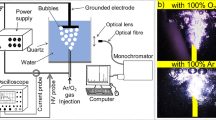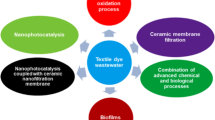Abstract
In the electrocoagulation of Drimarene Discharge X-3LG® (R12S) and Samaron Yellow 4® (D05H), the effects of sacrificial anodes, initial pH, rate of stirring and concentrations of dyes on the fraction of decolourization were tested. The experimental results revealed that the colour of dyes in the aqueous phase was effectively removed when iron and aluminium were used as sacrificial anodes and the concentration of the dyes was less than 100 p.p.m. When the concentration of R12S exceeded 300 p.p.m. iron was a more suitable sacrificial anode for electrocoagulation of R12S than aluminium. For the electrocoagulation of D05H in aqueous solution aluminium as a sacrificial anode was superior to iron when the concentration of D05H exceeded 300 p.p.m. Using iron as sacrificial anode, the residual concentration fraction of R12S was decreased below 10% when the initial concentration of R12S and charge passed were 500 p.p.m. and 120C, respectively. The decolourization fraction of D05H was 99% when aluminium was used as sacrificial anode.
Similar content being viewed by others
References
B. D. Water, ‘Treatment of Dyewastes’, in ‘Petroleum and Organic Chemicals Industries (Surveys in Industrial Wastewater Treatment)’, Vol. 2, Pitman Publishing Limited, London (1984).
T. R. Demanin and K. D. Uhrich,American Dyestuff Reporter 77 (6), (1988) 13.
D. K. Gardiner and B. J. Borne,J. Soc. Dyers and Colourists 94 (1978) 339.
V. E. Cenkin and A. N. Belevstev,Effluent and Water Treatment Journal 25 (7), (1985) 243.
E. C. Beck, A. P. Giannini and E. R. Ramirez,Food Technol. 18-19 (1974) 22.
A. N. Volkova, L. V. Ivanova and V. I. Yakovlev,J. Appl. Chem. USSR 54 (1981) 970.
T. Y. Pazenko, T. I. Khalturina and I. M. Murashov,55 (1982) 864.
T. Y. Pazenko, T. I. Khalturina, A. F. Kolova and I. S. Rubailo,58 (1985) 2383.
R. R. Renk,Energy Prog. 8 (1988) 208.
N. Biswas and G. Lazarescu,Int. J. Environ. Studies 38 (1991) 65.
S. P. Novikova, T. L. Shkorbatova and E. Y. Sokol,Soviet J. Water Chem. & Technol. 4 (1982) 82.
D. R. Jenke and F. E. Diebold,Water Research 18 (1984) 855.
N. P. Gnusin, N. V. Vitul'skaya, L. I. Zabolotskaya and I. A. Belobrov,J. Appl. Chem. USSR 50 (1977) 1663.
N. P. Gnusin, N. V. Vitul'skaya, L. I. Zabolotskaya and V. V. Treskov,51 (1978) 1187.
E. I. Sorkin and E. I. Kucheryavykh,56 (1983) 63.
J. Mroxowski and J. Zielin'ski,Environ. Protection Eng. 9 (1983) 77.
N. P. Gnusin, L. I. Zabolotskaya and N. V. Vitul'skaya,Soviet J. Water Chem. & Technol. 7 (1985) 43.
E. Dobolyi,Water Research 12 (1978) 1113.
O. Groterud and L. Smoczynski,20 (1986) 667.
K. C. Narasimham, S. M. Silaimani and K. I. Vasu,Bull. Electrochem. 5 (1989) 109.
E. A. Vik, D. A. Carlson, A. S. Eikum and E. T. Gjessing,Water Research 18 (1984) 1355.
F. W. Pontius, ‘Water Quality and the Treatment’, 4th edn McGraw-Hill, New York (1990).
Author information
Authors and Affiliations
Rights and permissions
About this article
Cite this article
Do, J.S., Chen, M.L. Decolourization of dye-containing solutions by electrocoagulation. J Appl Electrochem 24, 785–790 (1994). https://doi.org/10.1007/BF00578095
Received:
Revised:
Issue Date:
DOI: https://doi.org/10.1007/BF00578095




